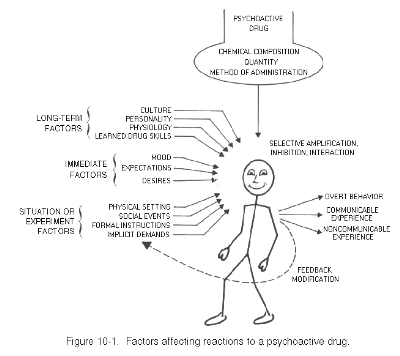

It is striking that so many of these medical reports fail to mention any intoxicating properties of the drug. Rarely, if ever, there an indication that patients—hundreds of thousands must have received cannabis in Europe in the nineteenth century—were "stoned," or changed their attitudes toward work, love, their fellow men, or their homelands...When people see their doctor about a specific malady they expect a specific treatment and do not anticipate being "turned on."
| Variables | Good Trip Likely | Bad Trip Likely | |
| Drug factors | Quality | Pure, known | Unknown drug or unknown degree of (harmful) adulterants |
| Quantity | Known accurately, adjusted to individual's desire | Unknown, beyond individual's control | |
| Long-term factors | Culture | Acceptance, belief in benefits | Rejection, belief in detrimental effects |
| Personality | Stable, open, secure | Unstable, rigid, neurotic, or psychotic | |
| Physiology | Healthy | Specific adverse vulnerability to drug | |
| Learned drug skills | Wide experience gained under supportive conditions | Little or no experience or preparation, unpleasant past experience | |
| Immediate factors | Mood | Happy, calm, relaxed, or euphoric | Depressed, overexcited, repressing significant emotions |
| Expectations | Pleasure, insight, known eventualitites | Danger, harm, manipulation, unknown eventualities | |
| Desires | General pleasure, specific user-accepted goals | Aimlessness, (repressed) desires to harm or degrade self for secondary gains | |
| Experiment or situation fctors | Physical setting | Pleasant and esthetically interesting by user's standards | Cold, impersonal,"medical," "psychiatric," "hospital," "scientific" |
| Social events | Friendly, nonmanipulative interactions overall | Depersonalization or manipulation of the user, hostility | |
| Formal instructions | Clear, understandable, creating trust and purpose | Ambiguous, dishonest, creating mistrust | |
| Implicit demands | Congruent with explicit communications, supportive | Contradictory to explicit communications and/or reinforcing other negative variables | |